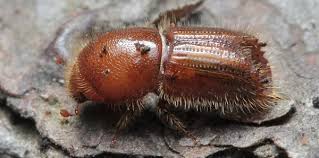There is an eerie feel to this grove of lodgepole pines that I can’t quite put my finger on as entomologist Diana Six tromps ahead of me, hatchet in hand, scanning the southwestern Montana woods for her target. But as she digs the blade into a towering trunk, it finally hits me: the smell. There’s no scent of pine needles, no sharp, minty note wafting through the brisk fall air.
Six hacks away hunks of bark until she reveals an inner layer riddled with wormy passageways. “Hey, looky!” she exclaims, poking at a small black form. “Are you dead? Yeah, you’re dead.” She extends her hand, holding a tiny oval, maybe a quarter of an inch long. Scientists often compare this insect to a grain of rice, but Six prefers mouse dropping: “Beetle in one hand, mouse turd in another. You can’t tell them apart.” She turns to the next few trees in search of more traces. Pill-size holes pock their ashen trunks—a sign, along with the missing pine scent, of a forest reeling from an invasion.
These tiny winged beetles have long been culling sickly trees in North American forests. But in recent years, they’ve been working overtime. Prolonged droughts and shorter winters have spurred bark beetles to kill billions of trees in what’s likely the largest forest insect outbreak ever recorded, about 10 times the size of past eruptions. “A doubling would have been remarkable,” Six says. “Ten times screams that something is really going wrong.”

